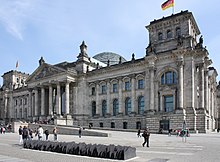Walter Schütz (politician, 1897)
Walter Schütz (born October 25, 1897 in Wehlau ; † March 29, 1933 SA barracks in Königsberg ) was a German politician (KPD).
Live and act
Schütz attended elementary school. He was then trained as a machine fitter. Later he worked in this profession, among other things, in the municipal electricity works of Königsberg.
After the First World War , Schütz lived as a car mechanic in Königsberg. At that time he also got married. At least one son, Gustav Schütz, emerged from the marriage. In 1919 he joined the Communist Party of Germany (KPD). Schütz quickly made a career within the communist movement, so that he finally rose to become chairman of the KPD in East Prussia . He also became editor-in-chief of the communist newspaper Echo des Ostens , which appears in East and West Prussia and which (incorrectly) claimed to be the most widely read newspaper in these provinces.
In September 1930 Schütz was elected for the KPD in the Reichstag , in which he represented constituency 1 (East Prussia). He was a member of the Weimar parliament for three legislative terms until March 1933. An acquaintance described Schütz for this time as follows: “A short, slim, wiry man who spoke in a broad East Prussian dialect at the meetings in villages and towns. It was always well received. "
After the Reichstag fire in February 1933, according to the Brown Book published in 1933 on the Reichstag fire and Hitler terrorism , Schütz was . arrested in the morning hours of March 29, 1933. He died a short time later while in detention, most likely from abuse and torture. An illegal leaflet called Alert! Read and share! Alarm! , which was circulating in East Prussia in April 1933, alleged the following circumstances of death: On March 27 or 29, Schütz was abducted "at 2.30 am" to an SA barracks and there "trampled into an informal, unrecognizable mass in the course of 12 hours, smashed and stabbed ”. He was then taken to a hospital. On the evening of March 29th, he died of his injuries and was "a corpse". The death certificate had to be issued to "heartbeat" by order of the SA. On April 3, he was then "buried like a wild animal". His death had been kept secret by the newspapers and the hospital staff had been silenced by threats. Schütz's widow was taken into " protective custody " during these days . In addition, she had to sign a lapel after the funeral, "according to which she pledged to remain silent, otherwise she would be imprisoned immediately and threatened with her husband's fate."
Commemoration
Since 1992 one of the 96 memorial plaques for members of the Reichstag murdered by the National Socialists has been commemorating Schütz near the Reichstag in Berlin .
literature
- Schütz, Walter . In: Hermann Weber , Andreas Herbst : German Communists. Biographisches Handbuch 1918 to 1945. 2nd, revised and greatly expanded edition. Dietz, Berlin 2008, ISBN 978-3-320-02130-6 .
Web links
- Walter Schütz in the database of members of the Reichstag
Individual evidence
- ↑ Martin Schumacher (Ed.): M. d. R. The members of the Reichstag of the Weimar Republic in the time of National Socialism. Political persecution, emigration and expatriation 1933–1945. Droste, Düsseldorf 1991, ISBN 3-7700-5162-9 , pp. 516f.
- ↑ Valentin Tomin: Behind the front. Documentary story about a German scout group , 1980, p. 61.
- ^ Heinz Brüdigam : Fascism in power. Reports, pictures, documents about the year 1933 , 1982, p. 234.
- ↑ Braunbuch 1933 p. 322, accessible in digital form
- ^ Heinz Brüdigam: Fascism in power. Reports, pictures, documents about the year 1933 , 1982, p. 234.
| personal data | |
|---|---|
| SURNAME | Schütz, Walter |
| BRIEF DESCRIPTION | German politician (KPD), MdR |
| DATE OF BIRTH | October 25, 1897 |
| PLACE OF BIRTH | Wehlau |
| DATE OF DEATH | March 29, 1933 |
| Place of death | Koenigsberg |
